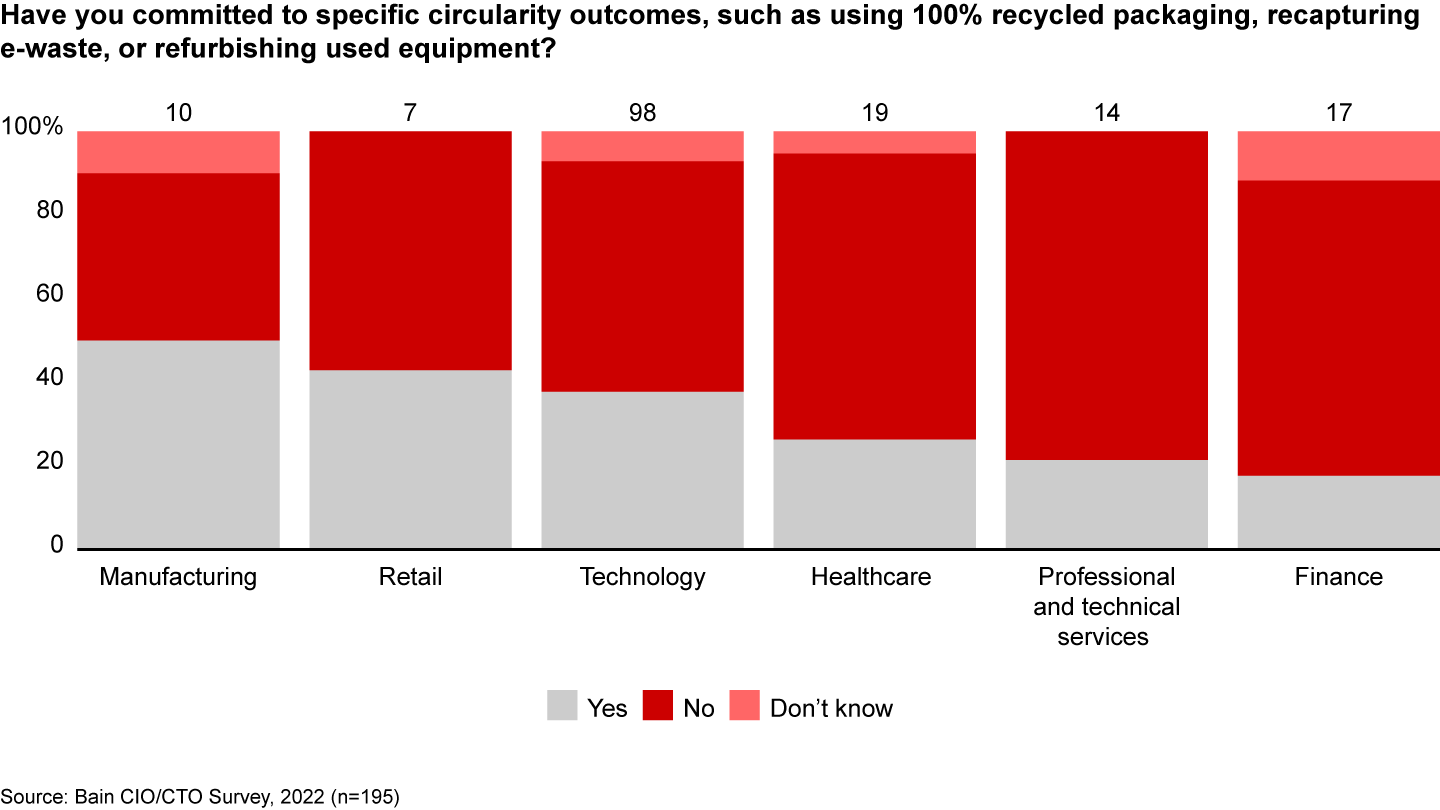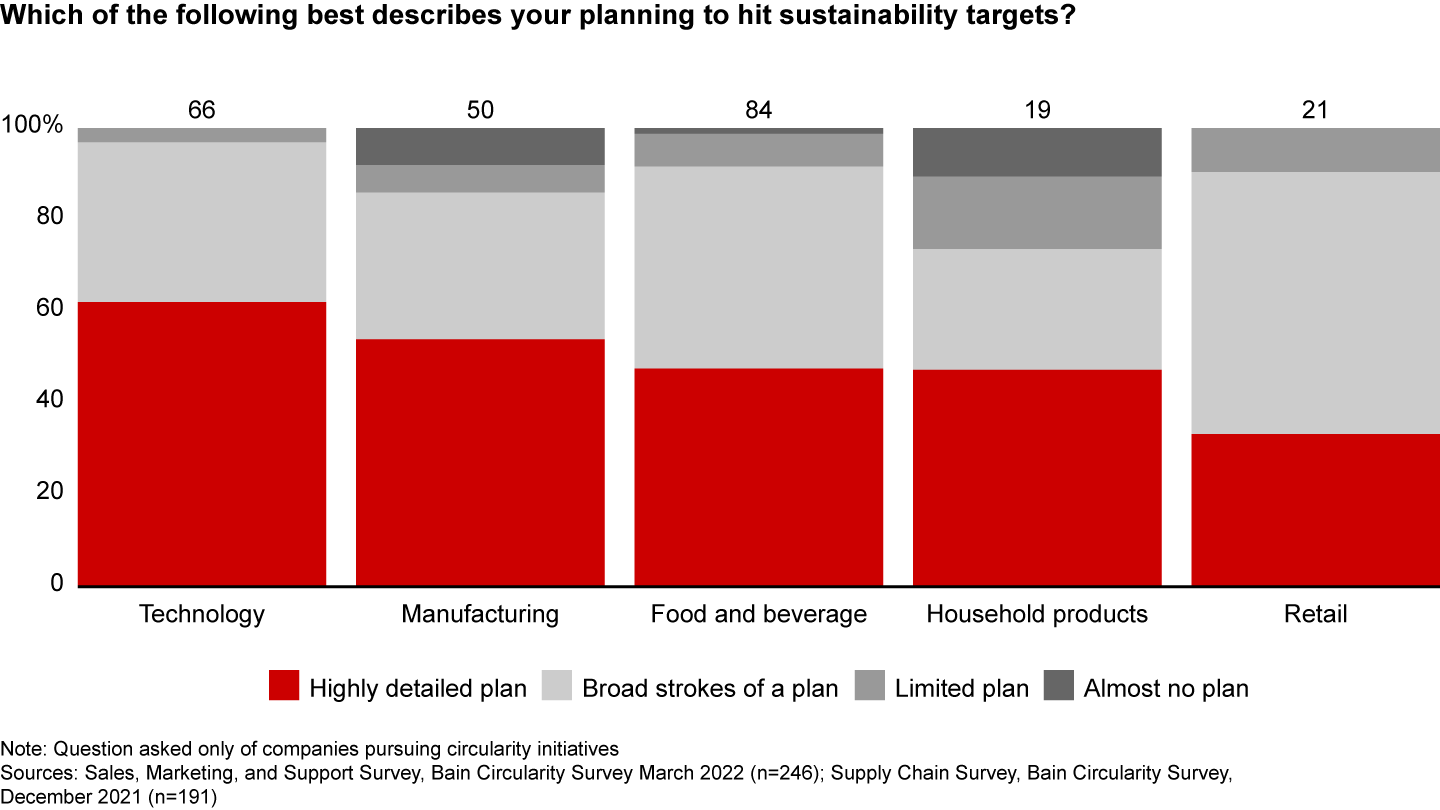Technology Report

At a Glance
- Technology hardware providers see new opportunities in circularity: the reuse, remanufacturing, and recycling of products and their components.
- Some companies are developing new revenue streams from selling second- and third-life products, which have been reclaimed from first-use customers and restored for resale.
- Circular supply chains have benefits, such as maintaining reliable supplies when inflation hits commodity markets, helping companies reduce waste and emissions, and staving off new competitors.
- Successful circularity efforts identify new ways to create value, anticipate disruption to profit pools, and plan for scale.
This article is part of Bain's 2022 Technology Report.
Technology companies are under pressure from investors, customers, and regulators to reduce their carbon footprint and become more sustainable. For some tech hardware companies, improving the circularity of their products—repairing, reusing, and recycling products and their materials—creates new value and supports their plans to become more sustainable, though most plans lack specific goals (see Figure 1).

Circularity can be particularly challenging in tech, where supply chains span continents, carbon footprints are large, and products are complex with short lives. The raw inputs for advanced technology products derive from a wide variety of sources, and improving circularity requires a deep understanding of the flow of materials before, during, and after the product’s useful life (see Figure 2).

But even with these challenges, the advantages and opportunities are hard to ignore. As inflationary pressures hit commodity markets and supply chain bottlenecks threaten to limit access to raw materials, executives are looking for new and innovative ways to ensure access to alternative sources of supply. Circularity also helps manage competition from other sectors for strategic materials, for example, battery materials such as lithium for electric vehicles. More circular and repurposed products could also earn a green premium from concerned customers.
If those are the carrots, there are also sticks. Regulations governing emissions and electronic waste are only going to increase, and more circular models will be essential to hitting those goals. Also, as more tech hardware moves to as-a-service models, providers will increasingly maintain ownership of the physical products, and circular models will help maximize reusability—and therefore, margins. Finally, private equity investors are wading in; if tech hardware providers don’t extend into second- and third-use revenue streams, others will take those profits for themselves.
Seeing these opportunities, some tech hardware leaders have set ambitious circularity targets. For example, HP has said that it’s designing products for long lives and to make it easier to recapture materials from products at the end of their useful lives. Dell has set a goal of sourcing all of its packaging materials and more than half of its product materials from recycled or renewable materials by 2030, and Apple has said that by 2030 every product it sells will have a net-zero carbon impact.
To meet such goals, companies are redesigning their products to make them easier to repair and more recyclable and are making plans to salvage and reuse valuable materials when products reach the end of their useful lives. This will require a coordinated internal strategy across product design, sales and marketing, and supply chain teams. And although most tech companies still don’t have specific circularity plans in place, our research finds that tech companies have more detailed sustainability targets than companies in other industries do (see Figure 3).

Some changes will be easier than others. But creating a more circular supply chain for any product is complex and will require the cooperation not only of the manufacturer, but also channel and other sales partners, along with the end consumer. Customers may not want to part with their old hardware or may not know the value in doing so.
Priorities of successful circularity programs
What can tech companies learn from circularity leaders that will help them develop momentum and generate new value? Successful circularity efforts focus on three priorities.
- Identify new ways to create value. Companies that view circularity through an investor’s lens can get a jump on competitors by identifying new control points and business models that take advantage of them. Apple’s planned iPhone subscription model is a good example, since it tilts the business more toward recurring revenue, which could do for hardware providers what the as-a-service model did for software. Interestingly, although tech hardware companies on average have more confidence in their ability to achieve their circularity goals than nonhardware tech companies, they’re less confident of reaping the benefits.
- Anticipate disruption. Leaders plan for the possibility of their profit pools being disrupted by more circular rivals. The more invested a company is in circularity, the more concerned it is about disruption because its leaders are more aware of innovation and may have an earlier view of which new upstarts and business models are gaining traction.
As tech hardware players face the headwinds of commoditization, they can complement their investment in innovations for first-life products with an alternative profit stream from second- and third-life products, thus supporting the investment required to stay on the bleeding edge. For example, Dell’s direct sales model is conducive to reclaiming and reselling its products for a second life, and that has allowed the company to build a robust business around refurbished equipment.
- Plan to scale. Companies will need to do three things to scale their circularity solutions. First, they’ll need to design products that can be repaired, refurbished, recaptured, and reused with less risk of damage, and are better suited for extracting recyclable materials. To ensure a pipeline of products to recycle, companies will need to retain ownership of the asset or create incentives for customers to return hardware, as some wireless carriers have with transparent pricing for buying back mobile devices when a customer upgrades.
Second, supply chains will need to adapt to a more circular model, which means products must be more traceable. Knowing which products have gone to which customers in which regions, whether or not they have been returned, and where these products and their components are in the return value chain will be critical to supply planning. To achieve this, leaders need to develop their circularity efforts on platforms that suppliers and other external partners can support.
Third, tech hardware makers will want to use technology to help disassemble products and optimize the mix of new and used. Apple uses artificial intelligence to predict the likely status of a returned device, the best channel to dispose of it (for example, resale or recycle), and the right offer to make on it.
Circularity is emerging as a necessity, and the tech hardware companies that move assertively to develop expertise and find the right business models—before regulators define the opportunities for them—will be more likely to meet their sustainability goals, achieve greater resilience in their supply chain, and capture higher profits from green premiums and second- and third-use revenue streams.


